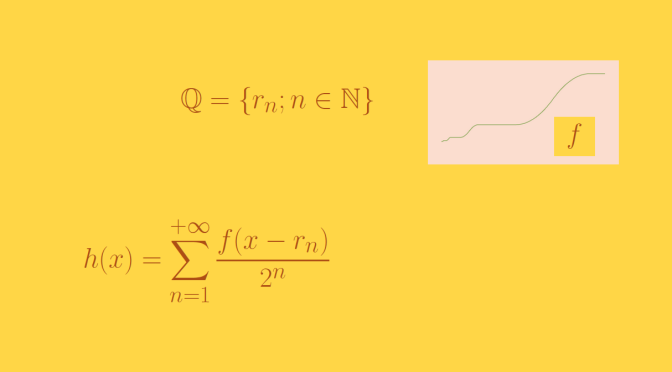We build here a continuous function of one real variable whose derivative exists on \(\mathbb{R} \setminus \mathbb{Q}\) and doesn’t have a left or right derivative on each point of \(\mathbb{Q}\).
As \(\mathbb{Q}\) is (infinitely) countable, we can find a bijection \(n \mapsto r_n\) from \(\mathbb{N}\) to \(\mathbb{Q}\). We now reuse the function \(f\) defined here. Recall \(f\) main properties:
- PR1
- \(f\) is continuous on \(\mathbb{R}\).
- PR2
- \(f\) has a derivative \(g\) on \(\mathbb{R}^*\) and \(\vert g(x) \vert \le 1\) for \(x \in \mathbb{R}\).
- PR3
- \(\vert f(x) \vert \le \frac{1}{3}\) for \(x \in \mathbb{R}\).
- PR4
- Therefore \(f\) is Lipschitz continuous and \(1\) is a Lipschitz constant for \(f\), i.e. \(f\) is a short map.
For \(n \in \mathbb{N}\) we define \(\displaystyle u_n(x)=\frac{f(x-r_n)}{2^n}\) and \(\displaystyle h_n(x)=\sum_{k=0}^n u_n(x)\). According to PR1 those functions are defined on \(\mathbb{R}\) and continuous. Let’s now consider the function series:
\[\begin{array}{l|rcl}
h : & \mathbb{R} & \longrightarrow & \mathbb{R} \\
& x & \longmapsto & \displaystyle \sum_{k=0}^{+\infty} u_n(x) \end{array}\] \(h\) is defined on \(\mathbb{R}\) due to PR2. PR2 also implies that \(h\) is normally convergent. Therefore \(h\) is continuous on \(\mathbb{R}\) as the \(u_n\) are continuous.
If \(a \in \mathbb{R} \setminus \mathbb{Q}\) we have \(a-r_n \neq 0\) for all \(n \in \mathbb{N}\) and according to PR3 \(u_n\) is differentiable at \(a\) with:
\[u_n^{\prime}(a)=\frac{f^{\prime}(a-r_n)}{2^n}=\frac{g(a-r_n)}{2^n}\] \(h_n\) which is a finite sum of functions differentiable at \(a\) is also differentiable at \(a\).
The inequality \(\vert g(x) \vert \le 1\) valid for \(x \in \mathbb{R}\) ensures that \(\displaystyle \sum_{n=0}^{+\infty} u_n^{\prime}(a)\) converges. We denote \(H(a)\) the sum of that series, \(H_n(a)=h_n^{\prime}(a)\) and
\[D(x)=\frac{h(x)-h(a)}{x-a} \mbox{ and } D_n(x)=\frac{h_n(x)-h_n(a)}{x-a}\] For \(p,q \in\mathbb{N}\) and \(x \neq a\) the following inequalities hold:
\[\begin{aligned}
\vert (h_q(x)-h_q(a))-(h_q(x)-h_q(a)) \vert &\le \sum_{n=p+1}^q \frac{\vert f(x-r_n)-f(a-r_n)\vert}{2^n}\\
&\le \sum_{n=p+1}^q \frac{\vert x – a \vert}{2^n} \le \frac{\vert x – a\vert}{2^p}
\end{aligned}\] Therefore \(\vert D_q(x) -D_p(x) \vert \le \frac{1}{2^p}\). For \(\epsilon > 0\), we pick up \(p \in \mathbb{N}\) in order to have \(\frac{1}{2^p} \le \frac{\epsilon}{3}\) and \(\vert H_p(a) – H(a) \vert \le \frac{\epsilon}{3}\), which is possible as \(\lim\limits_{n \to +\infty} H_n(a)=H(a)\). \(h_p\) is differentiable at \(a\) and \(h^\prime_p(a)=H_p(a)\). So we can find \(\alpha > 0\) in order to have \(\vert D_p(x)-H_p(a) \vert \le \frac{\epsilon}{3}\) when \(\vert x-a \vert < \alpha\) and \(x \neq a\). For \(x\) satisfying those last conditions we then have:
\[\begin{aligned}\vert D(x)-H(a) \vert &\le \vert D(x) - D_p(x) \vert + \vert D_p(x) - H_p(a) \vert\\
&+ \vert H_p(a) - H(a) \vert \le \epsilon \end{aligned}\] This proves that \(h\) is differentiable at \(a\) with \(h^\prime(a) = \lim\limits_{n \to +\infty} h_n^\prime(a)\).
For \(a \in \mathbb{Q}\), we can find \(p \in \mathbb{N}\) with \(a = r_p\). Following a similar proof than above, the function \(l_p: x \mapsto h(x) - u_p(x)\) is differentiable at \(a\). As \(f\) does not have left and right derivatives at \(0\), \(u_p\) does not have left and right derivatives at \(a\). finally, the equality \(h=l_p+u_p\) implies that \(h\) also does not have left and right derivatives at \(a\).
Conclusion: the function \(h\) is differentiable at all irrational points but does not have left or right derivative at all rational points.

